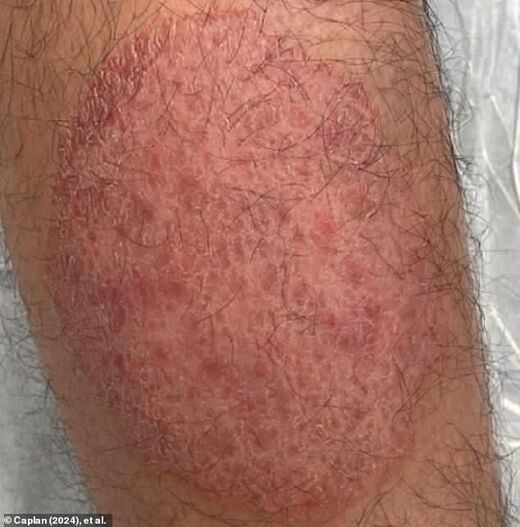
Symptoms of ringworm typically appear within four to 14 days after exposure and include an itchy rash that is circular in appearance, as well as redness, flakiness, peeling or cracking of the skin
The New York patient is the first documented case of the fungus being passed through sexual contact.
The infection, which is a rare type of ringworm, has been described by the New York University experts as a 'potential public health threat'.
Ringworm — sometimes referred to as 'jock itch' when it affects the groin — is a common mold-like parasite that lives on the body and is spread via contact with an infected person.
The condition can be extremely hard to cure, often taking months to treat with multiple medications and therapies.
The patient was a man in his thirties who visited the doctor because he developed a rash on his penis, thighs and buttocks after having multiple male sexual partners in the weeks prior.
Comment: And one wonders whether he was also the recipient of the experimental covid, and/or monkey pox, injection.
After taking a skin biopsy of his rash, he was diagnosed with tinea pubogenitalis, a rare sexually transmitted form of jock itch.
While ringworm has been observed on the groin before, researchers said this is the first instance in which tinea pubogenitalis had been transmitted to the area through sexual contact.
The condition is caused by the trichophyton mentagrophytes type VII (TMVII) fungus and cases have been on the rise throughout Europe.
Thirteen were reported in France last year, mostly in men who have sex with men.
Comment: As was also reported to be the case with the monkey pox.
Lead author and dermatologist Dr Avrom Caplan, a professor at NYU's school of medicine, said: 'Healthcare providers should be aware that Trichophyton mentagrophytes type VII is the latest in a group of severe skin infections to have now reached the United States.'
The New York patient reported recent travel to England and Greece where he said had sex with multiple men.
Study senior author Dr John Zampella, also a professor at NYU's school of medicine, said: 'Since patients are often reluctant to discuss genital problems, physicians need to directly ask about rashes around the groin and buttocks, especially for those who are sexually active, have recently traveled abroad and report itchy areas elsewhere on the body.'
The man was initially given an antifungal medication for four weeks but did not see improvement and was then put on a six-week course of another antifungal.
However, 'due to persistent infection,' he was put on a third antifungal for several more weeks until the rash cleared.
Ringworm, also known as athlete's foot when it occurs on the feet, can affect the skin, hair and nails and can also spread through contaminated surfaces like shower stalls or shared barber clippers.
Symptoms typically appear within four to 14 days after exposure and include an itchy rash that is circular in appearance, as well as redness, flakiness, peeling or cracking of the skin.
Though the New York researchers warned the rashes experienced by those experiencing tinea pubogenitalis may present differently and could be mistaken for eczema, leaving patients without relief for months.
Treatment for the infection includes non-prescription antifungal creams, ointments, lotions, powders or sprays, but it can take months to clear up. Prescription anti-fungals may be prescribed for hard-to-treat cases.
Dr Zampella added that even though infections caused by TMVII are difficult to treat and can take months to resolve, they appear to respond effectively to standard antifungal treatments.
Following the case report, the NYU researchers alerted the New York State Department of Health and plan on partnering with leading fungi experts across the globe to expand research efforts on newer fungal conditions and track emerging cases.
The findings were published in the journal JAMA Dermatology.
Source link

